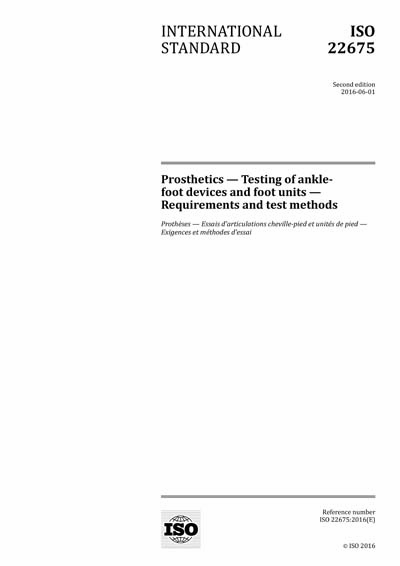Most recent
ISO 22675:2016
Prosthetics - Testing of ankle-foot devices and foot units - Requirements and test methods
IMPORTANT ? ISO 22675:2016 is suitable for the assessment of the conformity of prosthetic ankle-foot devices and foot units with the strength requirements specified in 4.4 of ISO 22523:2006 (see NOTE 1). Prosthetic ankle-foot devices and foot units on the market, which have demonstrated their compliance with the strength requirements specified in 4.4 of ISO 22523:2006 through submission to the relevant tests of ISO 10328:2006, need not be retested to this International Standard.
WARNING ? ISO 22675:2016 is not suitable to serve as a guide for the selection of a specific ankle-foot device or foot unit in the prescription of an individual lower limb prosthesis! Any disregard of this warning can result in a safety risk for amputees.
ISO 22675:2016 primarily specifies a cyclic test procedure for ankle-foot devices and foot units of external lower limb prostheses, distinguished by the potential to realistically simulate those loading conditions of the complete stance phase of walking from heel strike to toe-off that are relevant to the verification of performance requirements such as strength, durability and service life.
This potential is of particular importance for the assessment of the performance of a variety of recent designs of ankle-foot devices and foot units with specific characteristics that will only develop under realistic conditions of loading.
In addition, ISO 22675:2016 specifies a static test procedure for prosthetic ankle-foot devices and foot units, consisting of a static proof test and a static ultimate strength test, distinguished, besides other features, (see NOTE 2) by the potential to generate heel and forefoot forces at lines of action conforming to those occurring at the instants of maximum heel and forefoot loading during the cyclic test.
The loading conditions addressed in the third paragraph are characterized by a loading profile determined by the resultant vector of the vertical and horizontal (A-P) ground reaction forces and by a locomotion profile determined by the tibia angle.
The test loading conditions specified in this International Standard are characterized by standardized formats of these loading and locomotion profiles, to be uniformly applied by the cyclic and static test procedures to each sample of ankle-foot device or foot unit submitted for test.
International Organization for Standardization [iso]

